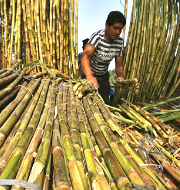Harnessing Pressmud for Sustainable Energy in India’s Sugar Industry
India has become a global leader in sugar production, surpassing Brazil since the 2021-22 period and ranking as the second-largest sugar exporter globally. The expansion of the ethanol biofuel sector over the last five years has not only strengthened the sugar industry but also enhanced the financial standing of sugar mills. A significant contributor to this success is the utilization of pressmud, a byproduct in the sugar industry, as a valuable resource for green energy production.
Pressmud: A Valuable Resource for Green Energy
Pressmud, also known as filter cake or press cake, is a residual byproduct in the sugar industry. It has proven to be a valuable resource for green energy production. Typically comprising 3-4% of the weight of processed sugarcane, pressmud serves as an excellent feedstock for biogas production through anaerobic digestion, leading to the creation of compressed biogas (CBG).
Advantages of Using Pressmud as Feedstock for CBG
Utilizing pressmud for CBG production offers several advantages:
- Simplified Feedstock Supply Chain: Pressmud eliminates the complexities associated with feedstock supply chains, as seen in the case of agricultural residue.
- Single-Source Sourcing: The feedstock is sourced from one or two producers or sugar mills, streamlining the procurement process compared to agricultural residue involving multiple producers.
- Quality Assurance: Pressmud’s quality is consistent, unlike municipal solid waste, reducing concerns about inorganic material damaging anaerobic digesters.
- Cost-Effective: Pressmud proves more economical than other feedstocks like agricultural residue and cattle dung, with a conversion efficiency that requires less input for the same gas output.
Challenges and Considerations
However, pressmud faces specific challenges:
- Rising Prices: Recognized as a potential revenue generator, pressmud prices have surged from Rs 100 per tonne to Rs 500-600 per tonne over the last two years.
- Competition for Use: Pressmud competes for use as fertilizer and in bio-composting, contending with spent wash and being used as fuel in brick kilns.
- Storage Challenges: Storing pressmud for the entire year, especially when sugar mills operate seasonally, poses challenges due to gradual decomposition, increasing production costs.
Regional Production and Potential
Uttar Pradesh and Maharashtra, primary sugarcane-growing states, contribute to approximately 65% of the total sugarcane cultivation area. With effective utilization, the 11.4 million tonnes of pressmud generated in 2022-23 has the potential to produce 460,000 tonnes of CBG, valued at Rs 2,484 crore.
Unlocking the Full Potential of Pressmud
To fully unlock the potential of pressmud, several interventions are necessary:
- Bioenergy Policies: States with high CBG potential should implement bioenergy policies to streamline project approval processes and provide incentives.
- Price Control Mechanism: Establish a mechanism to control pressmud prices to ensure economic viability for CBG plants.
- Extended Agreements: Encourage sugar mills to commit to extended agreements (10-15 years) with CBG plants to stabilize feedstock costs.
- Research and Training: Conduct comprehensive research on pressmud storage technologies to minimize methane emissions and provide training for CBG plant operators.
Month: Current Affairs - November, 2023
Category: Environment Current Affairs


